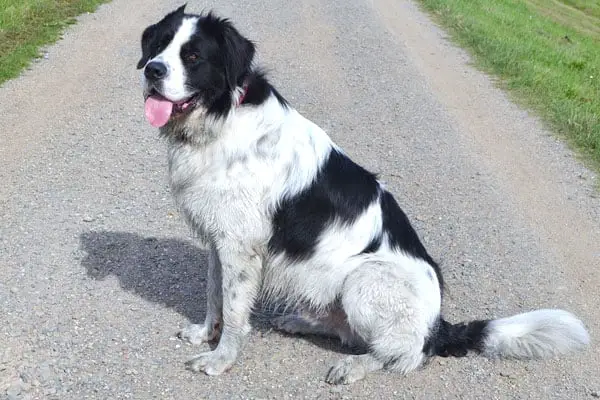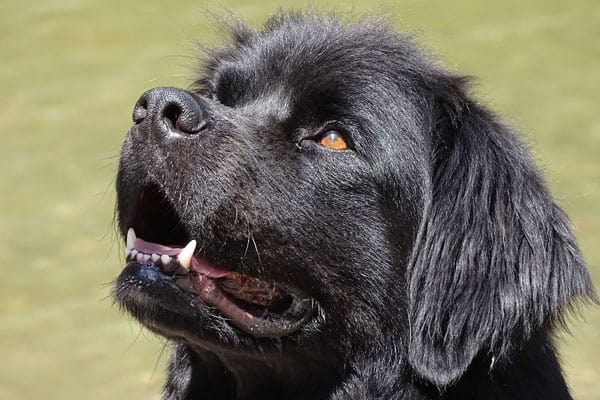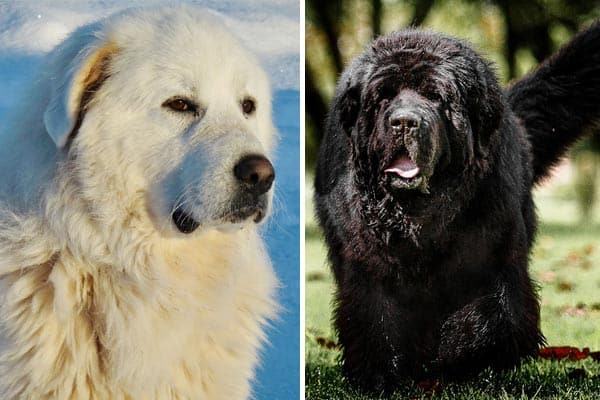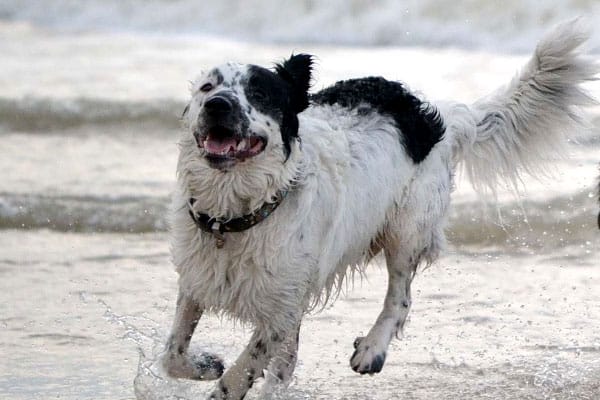Are Newfoundland Dogs Hypoallergenic: Read This Before You Get a Newfie

The Newfoundland dog is not just one of the most ancient of the modern companion canine breeds. This dog is also one of the most beloved.
If you have ever read or watched any version of the “Peter Pan” fairy tale, you probably remember “Nana,” the enormous family watchdog.
This canine character was based on the Newfoundland breed and is the reason why so many people know and love these dogs today.
But for people who suffer from pet dander allergies, the Newfoundland is definitely not the right dog breed to choose. In this article, we delve into detail about the Newfoundland’s hairy, double layer, shedding coat.
Are Newfoundland Dogs Hypoallergenic?
If there is such a thing as a hypoallergenic dog breed (technically, there really isn’t), then the Newfoundland dog might be considered the exact opposite of that.
These dogs start shedding in puppyhood and simply never stop. Not only do Newfoundlands shed seasonally in epic events that owners call “coat blows,” but they shed rather heavily year-round and on an everyday basis.
This is why it is definitely important to know what you are getting into with the coat care before you get a Newfoundland dog.
See How Much a Newfoundland Sheds During Grooming
In this short YouTube video made by a Newfoundland dog owner, you can see how much dead, shed hair the dog has already shed out just in a single session of brushing.
It is clear these dogs have a ton of hair, which makes them look very cute but is often something that first-time Newfoundland dog owners are completely unprepared to deal with.
What Is a Hypoallergenic Dog Coat (& Why Doesn’t the Newfie Have One)?
According to the esteemed Mayo Clinic, the concept of any dog being “hypoallergenic” is a myth.
While this was a great marketing ploy that some dog breeders used to great success for a time, the truth is that there isn’t a single dog breed that does not have the capacity to trigger pet allergies.
Why is this? Simply put, it is because the protein allergen that causes the sensitivity is actually not produced by the dog’s hair. It is produced in the dog’s saliva, urine, and skin.
The dander gets transferred to the hair when the dog licks the fur and uses the bathroom or when the hair falls out, taking a small amount of the protein with it.
Then the person with the pet allergies touches the hair and gets an allergic reaction such as sneezing, redness, itchiness, sore throat, and similar symptoms.
So then how did any dog get labeled hypoallergenic in the first place, you might be wondering?
Because different dog breeds can have very different coat types and textures, from long and silky like the Newfie to thick and curly like the Poodle, not all dogs shed a lot visibly.
In some breeds, the dead, shed hair gets caught in the surrounding hairs and never falls to the ground. So this can make it look like the dog doesn’t shed. But that dog is still shedding consistently – make no mistake about it.
Furthermore, the aggravating protein that causes the pet allergy is still being produced. It is just that when a dog doesn’t shed out visibly, there can be some chance the pet-allergic person may not come into contact with as much of the protein allergen.
The Newfoundland, because of this dog breed’s long, straight hair, sheds visibly. Most of the dead, shed hair does not get caught in the surrounding coat hairs but falls out and onto the ground or your pants or the carpet or wherever your dog happens to be.
This means that the Newfoundland owner will have a lot of daily brushing, grooming, sweeping, and vacuuming to do and there is a greater risk of coming into contact with the aggravating protein that causes pet allergies.
The bottom line here is simple: if you or someone in your family has a serious allergy to pets, the Newfoundland is not a good breed to pick.
Why Does the Newfoundland Dog Shed So Much?
The American Kennel Club (AKC) classifies the Newfoundland dog in the working group. The working group of canines is for dogs that were specifically bred to do certain types of work.
Most working group purebred dogs have a special kind of coat that is extra-protective and this is certainly the case for the Newfoundland.
This dog’s coat type could be described as follows:
- Long-haired outer layer.
- The outer layer is made up of water-repellant guard hairs.
- The inner layer is made up of soft and insulating thick shorter hair.
So you know that your dog has two full layers of fur – an outer layer and an inner layer. No matter how you look at it, that is a lot of dog hair!
And dog hair, like people’s hair, falls out periodically when the hair is no longer able to do its job well.
But unlike with people hair, which is mostly viewed as a fashion accessory today, dog hair is still mostly functional in its purpose. The hair is there to protect the dog’s skin and body from harm.
So when a hair becomes damaged, broken, or compromised in any way, it needs to get shed out and replaced with new functional hair.
Just looking at the Newfoundland dog makes it easy to see just how much shedding might have to go on in order to keep every single hair of the coat doing its best work.
How Often Do Newfoundland Dogs Shed?
As any experienced Newfie owner and they will tell you that Newfoundlands shed 24 hours out of every day, seven days per week, 365 days per year.
These dogs sometimes seem like they are all hair even separate and apart from their massive frames.
Vetstreet scores dogs from one to five based on how much grooming they need, with one being the least amount and five being the most amount of grooming. They give Newfoundland a five out of five for grooming.
Newfoundland dogs can shed while they are sleeping, eating, doing their business out in the yard, playing, swimming, or just sitting there doing nothing.
The reason is that they have to shed continually maintain their coat. But this doesn’t fully explain the more epic sheds they go through, which Newfoundland owners call “coat blows.”
What Are Newfoundland Coat Blows?
The term “coat blow” may conjure up images of a snowstorm of blowing dog hair. This is accurate, to hear Newfoundland dog breeders and owners tell it.
As the Newfoundland Club of America (NCA) explains, the process of brushing and grooming the Newfoundland coat can be a significant time investment on a daily basis.
But daily brushing and grooming is nothing compared to what you can look forward to when your dog begins “blowing coat.”
Coat blows happen seasonally, usually during transitions from cold to warm weather and from warm to cold weather. During these transitional times, your dog is self-regulating body temperature, either by adding more fur or by shedding out unneeded fur.
In the transition from the cold season to the warm season, your dog needs to shed quite a bit of that thick, insulating, downy inner coat layer to avoid overheating when it heats up outside.
In the transition from the warm season back to the cold season, your dog needs to shed out the summer undercoat and grow in functional fresh hair to keep them warm all winter long.
Throughout these periods, the outer layer of the coat will be shedding out continuously as individual hairs lose their effectiveness and are replaced with new hairs.
In order to understand why this needs to happen, it can help to learn a bit more about the Newfoundland’s coat. What is all that fur for, anyway?
Let’s Take a Closer Look at the Newfoundland’s Double Layer Coat
The Newfoundland dog, like so many dogs in the AKC working group category, has two coat layers. In fact, for all practical intents and purposes, this dog has two coats!
Why would a dog need two coats? The reason lies in the type of work that dog is bred to perform.
As Nanny Newfoundlands breeder explains, these dogs have a long history of serving alongside people on boats!
While the Newfoundland breed might not look like they would make great swimmers, they are so strong and powerful in the water they have often been used to make daring water rescues and to haul boats into shore using long rope leads.
Newfoundlands that have to swim in the open ocean or in extremely cold bay, lake, or river water need to have extra insulation to stay warm. They also need their coat to protect them from pests, abrasion, sunburn, and injury.
If either layer of a Newfoundland dog’s coat is not in good condition, that dog is in danger while going about their daily life. Pests, parasites, injuries, cold, heat, sunlight, and other dangers could reach the skin and cause injury and illness.
Newfoundland outer coat layer
The outer layer of the Newfoundland’s coat is charged with doing protection duty. This layer is very long and coarse with natural water-resistant properties.
This is the coat layer that is the most like your winter rain-proof overcoat.
Newfoundland inner coat layer
The inner layer of the Newfoundland’s coat is the one that has to help the dog regulate their body temperature. This layer is very soft – almost like down instead of hair – and is quite dense and thick.
This is the coat layer that is like the down comforter you like to sleep under at night.
How to Care for Your Newfoundland’s Coat
According to the American Kennel Club (AKC) breed profile page, the Newfoundland dog breed has an average lifespan of nine to 10 years.
This means that, for the next nine to 10 years on average, you will have to brush your dog at least once per day.
Of course, you could skip a day or few, but whatever shed hair you don’t brush out will then fall out all over your floor, car, clothing, and everything else your dog touches.
So most Newfoundland owners plan to brush their dog at least once per day every single day and more often during the coat blow periods.
Many owners learn how to trim and groom their dogs at home, while other owners prefer to take their dogs to the professional groomers periodically for coat trims, nail trims, ear cleanings, and other necessary health and hygiene maintenance.
You will want to start brushing your Newfoundland as early as the day you bring your puppy home. This will acclimate your puppy to the feeling and process of being brushed and also help manage the big transition from the puppy coat to the adult coat.
De-shedding rake or comb
You can use a de-shedding long-tine rake or stainless steel round-tip tine comb to make it easier to reach all the way down to the inner layer of hair to remove dead, shed hairs and keep tangles from forming.
If you do find any tangles, using a canine detangling spray can make it easier to work them out without causing your dog any pain.
Dog brush
Then you can use a dog brush made for large breed long-haired dogs to smooth and shine your dog’s coat.
During the coat blows twice per year, you may want to rake and brush your dog once each morning and once each evening until the transition period ends.
There is no doubt caring for a Newfoundland dog, with their massive double layer coat, is a lifetime commitment.
In exchange, you get a loyal, loving dog whose gentle yet watchful disposition more than makes up for all that shed hair.


